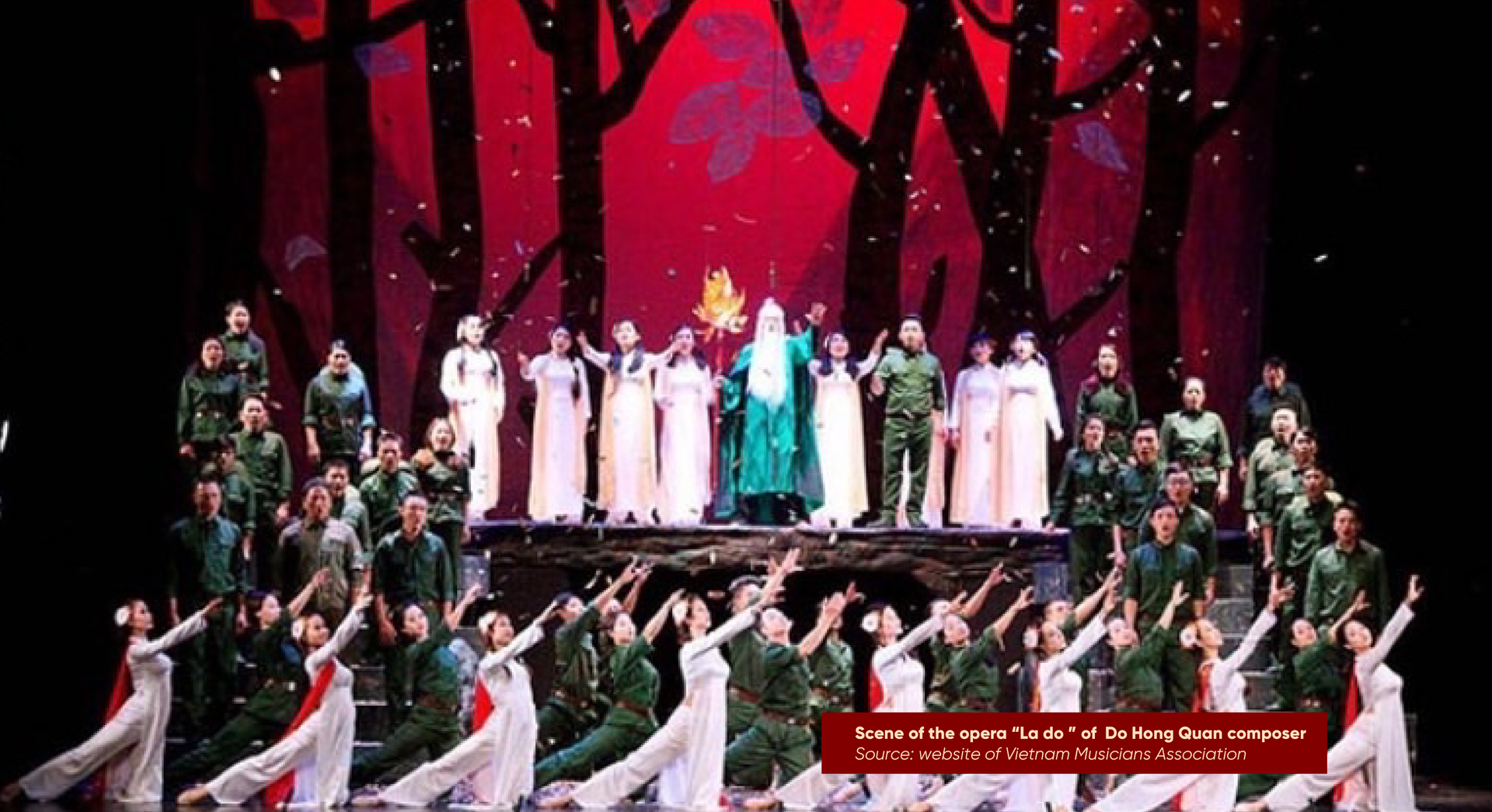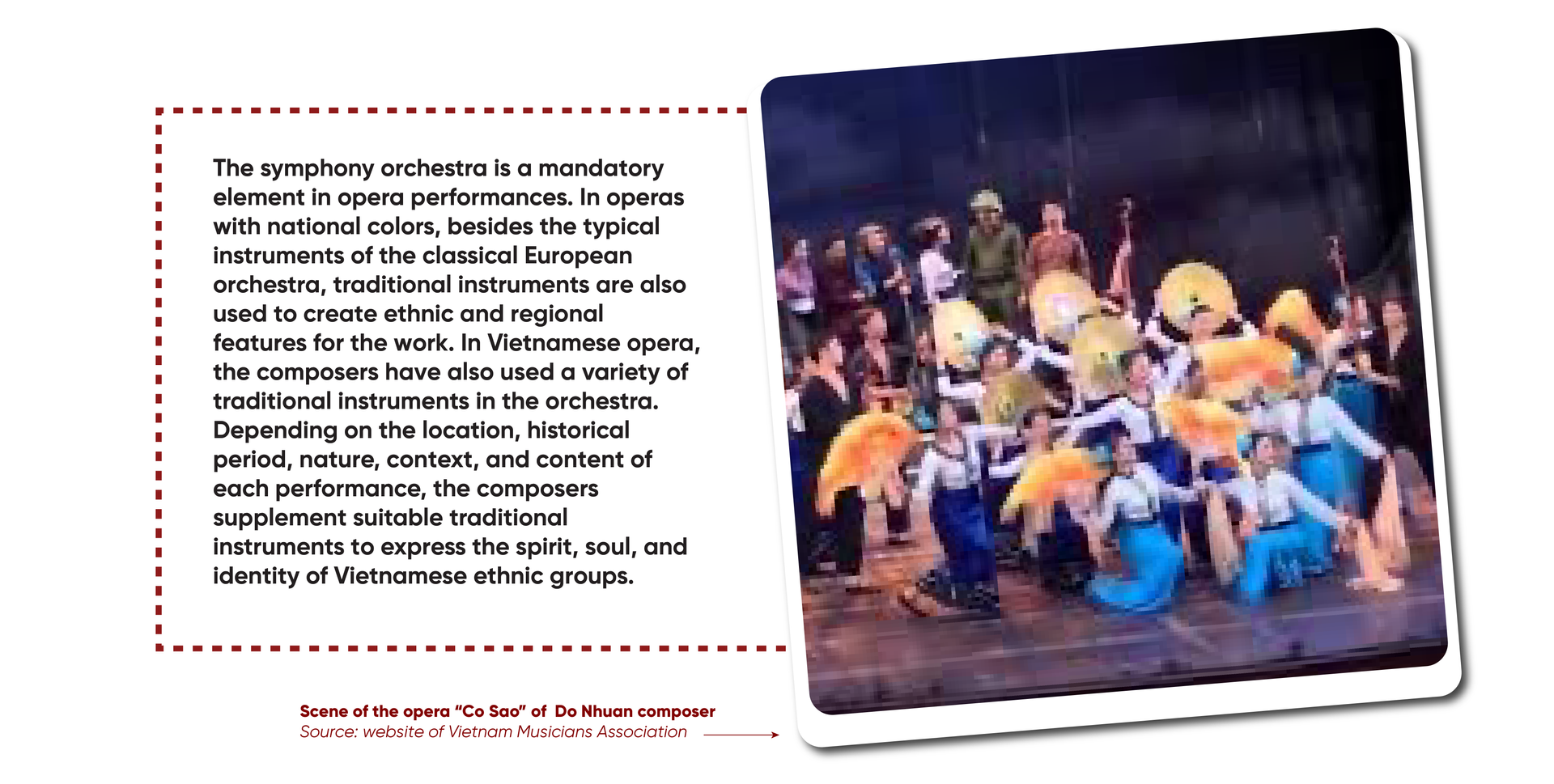Article 2: Expressive language and music components in Vietnamese opera
English - Ngày đăng : 08:33, 15/05/2023
.png)



Composer Do Nhuan used the rhyming speaking style of cheo (Vietnamese traditional opera) with a 4-character poetic form, such as: "She is a girl With a vampire..." This is the wicked words of a villain accusing Sao of being a vampire to alienate and disgust people. He also used one of the techniques of singing and speaking with many climaxes in tuong (classical Vietnamese opera) to portray Sao's character: "Evil troops fly They catch me here. Oh, high mountain, show me the way..." Or: "Am I a vampire?... I am a human, not a vampire" (Act 1, Scene 5)
Sao's character revealed her identity, and Sao's expression made the audience think the way you say to yourself as singing style in tuong, where the characters introduce themselves: "As for me, I am..." to introduce their own character.
As Sao's character belongs to the Thai ethnic group, the author also inherited the language of Thai folk poetry, such as: "Why can't I come up with a solution? Worried so much but to no avail Blood not flowing but the heart aches" (Act 1, Scene 12)

In another method, in the opera "Nguyen Trai in Dong Quan," Composer Do Nhuan used the poetic style of "seven sentences eight syllables " to create an impression of the past, appropriate to the context and content of the play. This poetic style shows the requirement of expression that is close to the style of singing and reciting ancient poetry. The portrait of Co Truc - a graceful, charming, talented girl - was depicted by the author in the form of Vietnamese ancient poetry: "...A cherry blossom is truly skillfully fresh School spring is full of laughter East wind must have some feelings Faint scent easily moves people" (Act 1, Scene 1)
As for Dao Xuan's character, with the grief and sadness contained within, the expression followed the form of Vietnamese folk poetry luc bat: "Asking the water-carrying flower vendor Who knows my heart in this place Remembering someone and silently weeping Two lines of tears, deep like rain" (Act 1, Scene 1)
Or, in another scene, Dao Xuan played the instrument and poured wine for two Chinese officials while singing in a drunken state with bitterness about life through verses of poetry luc bat intertwined with the background music: "ơ...i i hư ư hừ.. hư hư hư...ớ ơ" in the style of ca tru singing. In another dramatic situation, the author used the "bien ngau" style: matching verses, matching sentences, quoting idioms and classics. Dao Xuan sang, "God has eyes, evil people will face retribution, the snake carrying thief will bite the house's chicken"; "...Even if the East Sea's water is all dried up, the smell won't go away, even if all the bamboo in Nam Son is cut down, the sins won't be erased. Both gods and humans are angry, and the heavens and earth won't forgive" (Act 1, Scene 1, number 11).
Especially when watching the opera "Red Leaves," the audience can feel the performance has both ethnic colors and modern artistic features, not only in the musical script but also in the literary script. During the scriptwriting process, playwright Nguyen Thi Hong Ngat incorporated the distinctive elements of cheo, a traditional art form in Vietnam. She analyzed, "Ethnic drama teaches about expression, stylization, and embodiment. The stylized stage allows young women to sacrifice themselves to become images that are both real and imaginary, carrying great meaning for human life, making them immortal. And the mountain deity character is also my creation. I want to make the Truong Son range not only appear in the dialogue of the characters but also clearly as a character. I turned that deity into a narrator. Like in Cheo plays, there is a narrator, a stylized element of ethnic drama. Although it's a bit of a fairy tale, a bit of a legend, it's entirely reasonable..." (Excerpt from Nguyen Thi Hong Ngat's comment in the article "Red Leaves Opera - the harmonious combination of scholarly music and folk music" by Phuong Nga published in Van Nghe Magazine - Voice of Vietnam Radio - VOV on June 8, 2016).
The expressive language in Vietnamese operas has been expressed very distinctly, richly, and abundantly by the composers depending on the historical context and space that reflect the story, the regional style, and the unique characteristics of each ethnic group.


To describe the majestic forests and the wind-swept hills of Northwest Vietnam, the orchestra has used the sound of the bass drum, gongs… (in scenes 1, 2, 3, 4, 11 act 1 and scene 28 act 3 in the opera "Co Sao"). In the dance scenes with Northwest ethnic features of the Xoe dance group and Co Sao, the orchestra has used the characteristic instrument of the tinh (in scenes 11, 15 act 1, and scenes 19, 20, 21 act 2 in "Co Sao" opera).
In the scenes with the melodies of the Central Highlands, with dances of ethnic groups during festivals, there are always the participation of traditional instruments such as the t’rung and k’longput (scene 5 act 1 in "Ben bo K’rong Pa" opera); gongs, chiengs, and drums of the Central Highlands (scenes 3, 4, 7, 14 act 1 and scene 9 act 3 in "Ben bo K’rong Pa" opera); or the performances of the old lady Ma Tong, reciting the epic of the village, and calling for the trade of the village... Besides the sound of the gongs and chiengs, there is also the sound of the goong , portraying the image of the village patriarch with the goong in his hand (scenes 7, 10 act 1 and scene 5 act 2 in "Ben bo K’rong Pa" opera).
Some traditional instruments such as bells, wooden sticks, so na horns, and the ethnic percussion set are used throughout the scenes with religious colors, creating a highly impressive and effective atmosphere. In the setting of the temple, the image of Nga reciting prayers to Buddha, asking for compassion to save sentient beings, and hoping for peace of mind... (scene 1 act 1 and scenes 8, 9 act 2 in "Tinh yeu cua em" opera), or the performance of Cau Phat, when the Mountain God infuses power into the red leaves to retrieve the souls of the girls, the cave door opens, the blue sky, and the girls become fairies flying up... (scenes 33, 34 act 2 scene 6 in "La do" opera).
Traditional instruments are always present in the festivals of the Central Highlands, festivals of ethnic minorities such as gongs, chiengs, and drums of the Central Highlands, t’rung, goong , k’longput, and tinh. The traditional instruments used in traditional theater stages such as drums, snares, five bells, so na horns, wooden sticks, thanh la, tam, bau, and nguyet are also widely used in Vietnamese operas. They greatly diversify the performances and deeply penetrate the traditional cultural identity of the Vietnamese ethnic groups and the human soul of Vietnam.
